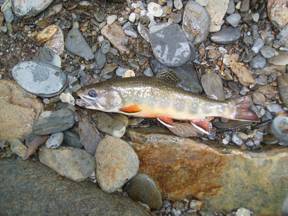
Splendor of the Spec by Don Winningham Let’s revisit how Harry Middleton describes the brook trout in the book, On the Spine of Time. By the way, this is a book that all Smoky Mountain anglers should read – trust me. As recently as the early 1900s, there was only one trout in these high country waters – Salvelinus fontinalis, the brook trout. Mountain people called them “specs” because of their brilliantly speckled and mottled backs. Actually, the skittish brook trout is not a true trout at all. It is properly a member of the char family, whose differences from true trout are mostly skeletal, though there are also some differences in arrangement of teeth and scale patterns. Perhaps the most apparent difference and the most pleasing, though, is that of color and character. Char, as a family, are somber and have an almost funereal coloring upon which there is a breathtaking and chaotic display of spots that are much brighter in color. It is a color scheme exactly the opposite of the rainbows and browns where darker spots or stripes are seen against lighter-colored bodies. When rising, its back in the light, a brook trout seems to flash a gallery of shallow scars across the length of its back. In full light these marks are wide, often honey-colored, sometimes pale yellow, a color which makes them look like tunnels of light isolated in a black world. Wrinkles of trapped sunlight. A friend of mine who never gets enough of specs likes to believe these twisted markings are the remnants of some lost evolutionary map, turnings of seasons and years, the inexorable movement of water. Time endlessly passing. Another angler I know, a man with a more practical turn of mind, scoffs at such nonsense. “Its nothing but fish camouflage,” he says. His voice is firm and doubtless, “Nothing but.” It’s hard to take sides, especially when watching a brook trout rise in cold water, the light settling in those wormlike tracks across its black back, making them look like tiny islands of light rising on some dark sea, islands of light rising up out of the cold, fast water. Rising. There is no question that the beauty of these char is a leading factor in our hiking long distances, crawling across boulders, and casting until our arms are aching to attempt to seduce them to our wound hair and feather forgeries. We admire their beauty, but this is not the only factor in our endless desire to spoof the spec. As Harry alluded to, the specs are native to our home waters. They belong in those mountain streams as sure as the boulders they seek protection around. They were a part of the mountains long before mankind began to cast a fly in the streams. Of course, mankind tried to destroy their habitat by removing the canopy of trees that provided the cool water in which they made their home. These great survivors climbed higher in the mountains above the reach of the loggers. They survived and are still a part of the natural beauty of the mountains. So, to catch one of these splendid survivors brings me closer to that which is real, and for a brief moment, I am immersed in their natural world, lost in its vast space and beauty. Oh how I respect the spec! I don’t want to leave out the pleasure gained from developing the skill level and knowledge necessary to select the appropriate fly, cast the fly to the correct spot, and obtain the proper drift required to make these wary fish believe the fly is really the aquatic insect it represents. While they are aggressive, these guys are easily spooked and hard to fool. It really takes some time to become an effective mountain fisherman. If you also tied the fly you fooled that ole boy on, well that just adds to the pleasure. I guess I have written enough about something you already know if you have fished for these wonderful survivors. So, the next time someone asks you how big the fish was that you caught on your trip to the mountains or why you did not bring them all home, just smile and tell them that they were bigger than you can imagine and more beautiful than any fish you have ever seen. Tell them that you hooked a fish that pulled you into a world that they may never experience - the World of the Brook that was beyond Spec-tacular.
|

